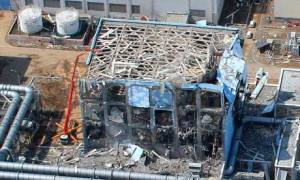By Daryl G. Kimball
Today, the people of Japan and people the world over pause to remember the nearly 20,000 people killed and unaccounted for as a result of the March 11, 2011 earthquake and tsunami disaster.
 An aerial view of the Fukushima Daiichi nuclear power, two weeks after the tsunami struck Japan.
An aerial view of the Fukushima Daiichi nuclear power, two weeks after the tsunami struck Japan.
Japan is also still reeling from the man-made nuclear reactor meltdown calamity at TEPCO's Fukushima Daiichi complex, which will exact an enormous human, environmental, and economic price for decades to come.
And, of course, we are still learning about the causes of Fukushima disaster, how a repeat can be avoided, and what it tells us about other nuclear-related dangers. There are some dedicated, independent Japanese NGOs that are working hard to hold their policy makers and nuclear power operators accountable, such as the Tokyo-based Citizens Nuclear Information Center.
The comprehensive report of the independent investigation panel established by the Rebuild Japan Initiative Foundation (available from The Bulletin of the Atomic Scientists) is a must read analysis of the nuclear disaster and response. In the report, which was published earlier this month, the panel lays much blame on the "myth of 'absolute safety' that nuclear power proponents had nurtured over decades and was aggravated by dysfunction within and between government agencies and Tepco, particularly in regard to political leadership and crisis management."
But for Sunday readers of Arms Control Now, I'm posting a shorter essay I wrote on the "Early lessons from the Fukushima nuclear crisis" less than a month after March 11, 2011 at the request of the editors of Kyodo News.
Early lessons from the Fukushima nuclear crisis
TOKYO, March 20, 2011 Kyodo - The overwhelming tragedy of the earthquake and tsunami that hit northeastern Japan has been compounded by the steadily worsening emergency unfolding at the Fukushima Daiichi reactors.
While the full extent of the nuclear disaster is not yet clear and will likely play out for weeks and perhaps much longer, it is not too soon to begin the process of assessing how to reduce the inherent risks of nuclear technology.
First and foremost, the current crisis underscores several important facts: the real life-cycle costs of nuclear energy are far higher than advertised; the public safety and security risks higher and more difficult to address than nuclear operators and government regulators often will admit; and even good disaster preparations can fall short.
The operators of Japan's Fukushima Daiichi reactors planned for severe earthquakes but not necessarily the additional impact of a tsunami and the loss of power for the backup cooling systems or the apparent earthquake-induced damage to the spent fuel storage pools. The Tokyo Electric Power Company appears to have responded too slowly and underestimated the dangers.
The focus now must be to deliver enough water fast enough to avert a full-scale meltdown, if that is still possible. But in time, the Japanese people deserve to understand what decisions contributed to the disaster. They are owed changes in nuclear regulations that help avoid similar misjudgments at other nuclear facilities.
Second, the unfolding nuclear crisis underscores the importance of improving transparency and openness. TEPCO and the Japanese central government have been slow in delivering information about the condition of the reactors, their actions to address the problems, and the extent of the radiation contamination. Such information is essential to responsible public health decisions, eases unfounded fears, and reduces distrust of official statements and advisories.
Third, in the wake of the Fukushima nuclear disaster, nuclear regulators, operators, and the public must push for greater margins of safety even if that results in higher costs and project delays. They must also be willing to phase out reactors and suspend or modify nuclear waste management practices that do not or cannot meet tougher standards.
Some nations, particularly in the developing world and in earthquake zones, may find they do not have the capacity to deal with the risks and potential consequences of nuclear energy.
Japan in particular must look to reduce nuclear risks by eliminating the added risks of reprocessing spent fuel to separate plutonium and burning mixed-oxide fuel, which contains plutonium.
TEPCO's focus on averting a meltdown of Fukushima Daiichi unit 3 appears to be driven, in part, by the fact that it contains MOX fuel. A fire or explosion there could release highly toxic plutonium particles.
Other problems plague the MOX program: Japan's Rokkasho reprocessing facility is costly ($28 billion) and has been repeatedly delayed.
Eliminating the riskiest nuclear projects, including those involving plutonium, and taking additional steps at remaining nuclear facilities can help mitigate the risks but cannot eliminate them.
Complex systems are vulnerable to failure from unanticipated events; the consequences of failure are greatly increased when they involve toxic materials. Nuclear power cannot be made completely ''safe,'' nor is it clean or green.
Finally, the Fukushima disaster is a stark reminder that we cannot afford to be complacent regarding that other radioactive danger: nuclear weapons. As the people of Japan know better than anyone, the impact of just a single nuclear bomb explosion is far more devastating.
Yet today there remain nearly 20,000 nuclear weapons. Whether the danger comes from potential conflicts on the Korean peninsula and in South Asia, terrorist acquisition of nuclear bomb material, or an accidental nuclear exchange between the superpowers, we can and must press the world's leaders to accelerate action on the steps needed to eliminate these most deadly weapons.
(Daryl G. Kimball is the executive director of the nongovernmental Arms Control Association in Washington and former director of Physicians for Social Responsibility's program on the health and environmental consequences of nuclear weapons production and testing.)
